|
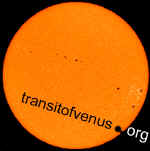
|
University of Notre
Dame
and
The Napoleon III Telescope
|
by
ROBERT J. HAVLIK, LIBRARIAN EMERITUS
UNIVERSITY OF NOTRE DAME
February 2003

[Note: For University of Notre
Dame
and the 1874 and 1882 Transits of Venus, see nd1800s.htm.]
I want to thank Flora for inviting me to talk to your group again. On previous
occasions I talked to you on World's Fairs and Abraham Lincoln. This time I
wanted to do something different, and decided to talk to you about the famous
Notre Dame Napoleon Telescope.
Spring 2003 marks the 136th anniversary of the acquisition of a magnificent
six-inch refracting telescope that became the center piece for the foundation of
early instructional programs in astronomy, and the building of several
observatories on the campus of the University of Notre Dame. Over the years the
telescope has undergone much modification and neglect. However, its lens is
still in good order and it is still in use today. The observatories which housed
it have also had a long and tortuous history, starting with its own building and
classrooms which were moved and rebuilt several times, until its ultimate
demolishment in the 1930's. In the mid-1960's an observatory of sorts was
re-established on the roof of the Nieuwland Science Hall, where the modified
telescope now remains, protected by a metal sided shed.
The early astronomy program was also influenced by several interesting
individuals, who are now somewhat forgotten, but whose lives need retelling to
give them the recognition the deserve.
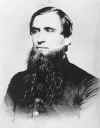 FR. CARRIER
In the year 1866, the President of the University of Notre Dame was Rev. William
Corby, C.S.C.. Corby was a veteran of the Civil War and was well known for
his blessing of the troops before the Battle of Gettysburg. Another Civil War
veteran, Father J. C. Carrier, C.S.C. was on his staff at the University,
serving as a member of the faculty, member of the Council of Administration and
as Librarian. Fr. Carrier also had a deep interest in science. In the Spring of
1866, Rev. Currier was sent to France for seven months, on business for the
University and for the Congregation of the Holy Cross. While there he was
authorized to procure a number of gifts and items, such as books, scientific
instruments and natural history objects for the University and its museum.
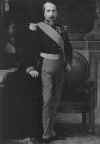 NAPOLEON III
NAPOLEON III
The visit was also to include an audience with Emperor Napoleon III who
was a friend of Notre Dame Founder Father Sorin.(1,2)
It was an exciting time in Paris that year with all of the planning for the
Paris 1867 Exposition Universelle. After a seven month's stay, and shortly after
the Exposition opened, Father Currier returned to the United States and the
University with twenty large boxes of treasures, ranging from a collection of
two hundred volumes presented by the French government, numerous church
ornaments and sacred vessels presented by the Emperor, Empress and the Prince
Imperial, and a six-inch refracting telescope inscribed, in French,
"Presented by his Imperial Majesty Napoleon III, to the Catholic University
of Notre Dame du Lac, Indiana, United States." These were great
treasures, all in time to celebrate the silver jubilee of the University. The
importance of the gift of the telescope was duly noted by the local South Bend
newspaper in an article entitled, "Magnificent Present to Notre Dame
University", as well as by several Catholic newspapers.(3.4,5)
FOUCAULT
[Note: An image shown here previously that was labeled as Foucault was
erroneously an image of Hippolyte Fizeau. We apologize for the
error. Thanks to William Tobin for pointing it out. See caveat
from our companion site.]
 TELESCOPE FROM CATALOG TELESCOPE FROM CATALOG
The gift telescope was mounted on a white walnut framework, the azimuth was
adjusted by a system of chains and the equator by gears. The telescope was one
of a set made for the French Government and not for commercial use. The
manufacturing firm, Secretan, is still in existence in Paris. (8) The telescope
was valued at 25,000 francs. Here is a picture of a similar telescope that was
on sale about 15 years ago.
 TELESCOPE IN GARDEN
TELESCOPE IN GARDEN
When the telescope arrived at the University in Spring 1867, it was placed in a
class room until a temporary observatory could be built. Professor Timothy E.
Howard was placed in charge of the use and maintanence of the telescope. Later
the Notre Dame Scholastic (9) noted that the telescope was being removed
to the Missionaries' Home on the far side of St. Joseph's Lake, presumably for
better viewing conditions. By December 25, 1869, construction of a
permanent observatory was underway but there were delays because of inclement
weather. (10) The building was finally reported to have been completed by
April 1870. (11)
 MAIN FRONT. OBSERVATORY ON RIGHT
MAIN FRONT. OBSERVATORY ON RIGHT
A contemporary account of the facility describes it as, a "small but
convenient building" located in the garden in front of the College
building. It had a revolving roof which was eighteen feet in diameter. The
telescope was mounted on a portable stand which rested on a column of masonry
passing from the ground up clear through the floor. (12)
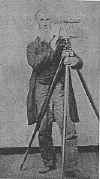 BRO. PETER BRO. PETER
The design and selection of the location for an observatory was in charge of
Brother Peter. John Fitzpatrick, known as Brother Peter, was born September 14,
1807 in Dublin, Ireland. He came to America as a boy. He married and had two
children. He settled in Goshen, Indiana, and became a prominent and very
successful merchant. In 1856 his family was wiped out during a cholera epidemic
in Goshen. He then disposed of all of his holdings and joined the congregation
of Holy Cross and became Brother Peter. His file in the University Archives is
very touching for it contains a small paper envelope containing a lock of his
wife's hair.
Father Sorin, founder of the University, had struggled for years to have a post
office at Notre Dame. His wish was personally granted by Henry Clay and in
1856 the first post office building was built. Although Fr. Sorin was appointed
the official post master, Br. Peter was assigned duties as, “ postmaster, and
storekeeper accordingly at the Post Office where he will sell books to the
Congregation.” He retained this post for many years.
In the early years of the University it was the custom for the Brothers,
Priests and Professors to perform a variety of duties on the campus as well as
teach a spectrum of subjects to the students. Over the years Br. Peter also
planned the garden in front of the Main building, assisted in various design and
construction projects on Campus, and taught surveying and astronomy classes. He
also had a talent for painting and drawing. He took particular pleasure in
constructing ornate vertical sun-dials which were placed around the campus
as well as at an orphan asylum near Lafayette, Indiana. He took pride as, “one
Brother who knows ‘peas from beans.’” Brother Peters special love,
however, was for the teaching of astronomy. During the next dozen years or so,
before his death, he published a long series of articles on the history of
astronomy, based on some of the classical French books received along with the
telescope gift. He also published a series of articles just before the Transit
of Venus of 1874 which were reprinted across the country.
 BRO. PETER PUBLICATION
BRO. PETER PUBLICATION
In the early days there were also several small telescopes on campus, built by
M. E. Solomons of Dublin, Ireland, and use of the telescope was a popular
student hobby. Br. Peter had his own telescope, which was considered, “the
best on Campus” and he was frequently called upon to assist students in
various terrestrial telescope contests. In the November 27, 1869 issue of
the Notre Dame Scholastic (13) there appeared a rather humorous
article about students using their small telescopes and binoculars in a contest
to count straws in a straw stack across the road from the University. The
contest was settled by Brother Peter, who had the best telescope, who said
he could count the number of curls in a pig's tail, behind the hay stack. The
article also informs us that:
"Telescoping seems to be the order of the day now, as Professor Howard is
building an observatory in the midst of a flower bed for his huge nine-footer
Imperial Paris glass. I hope he may be successful, but I hear that there is some
idea of getting one of Mr. Solomons, three-feet Celestial Telescopes with a
three-inch field and of wondrous power. If these two fine
instruments are placed on exhibition in Notre Dame, a visit to the observatory
must be very interesting; and I hope to be able to enjoy that pleasure as soon
as possible.".
 FACULTY AND TELESCOPE
FACULTY AND TELESCOPE
The writers wishes were fulfilled by April 1870, when the students of the Senior
Department of the University purchased a Solomons telescope which they presented
as a token of their esteem to Fr. Corby, upon his return from a trip to the West
to visit various houses of his Order.(14, 15) The telescope was described
as, "a beautiful astronomical telescope, mounted on a metallic stand. It is
three feet and a half long, with an achromatic field-glass three inches in
diameter, with a rack and pinion to arrange the focus, and changing eye-pieces
to suit all purposes. We believe it equal, if not superior, to any other glass
of its size ever imported." The article was probably written by Arthur
Joseph Stace who was also teaching Astronomy at the time.
 FACULTY AND STUDENTS
FACULTY AND STUDENTS
A visit to the campus and the University Observatory was quite a popular thing
in those days.. One notable visit occurred in September 1877 when members of a
South Bend “literary club” consisting of some 15 or 20 young women came for
a viewing and were duly noted by the all male student body.(15a)
As mentioned earlier the telescope and observatory were under the care of
Timothy Howard. Howard was to later gain fame as an important South Bend and
Indiana State civic leader. He was also founder of the Notre Dame Law School.
Howard Park in South Bend, as well as a residence hall at Notre Dame were named
after him.He was also founder of the St. Joseph County Historical Society.
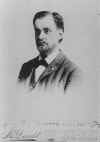 TIMOTHY HOWARD
TIMOTHY HOWARD
Timothy E. Howard was born on a small farm near Ann Arbor , Michigan. In 1859 he
entered Notre Dame and earned his undergraduate degree by tutoring minims, who
were young pre-teen students who were part of the overall educational program of
Notre Dame. He earned his Masters degree and served in the Civil War where he
was woundeed.. After the war his first position at Notre Dame was as a
professor of English. However, he had an interest in astronomy and soon placed
in charge of the new telescope. Many of the early photographs of the
telescope are of Howard and his astronomy students.
 HOWARD AND STUDENTS
HOWARD AND STUDENTS
Howard's ambitions, however, extended beyond Notre Dame and he earned a Notre
Dame Law degree in 1873. He then entered local politics, was elected to the
Indiana Senate and eventually became chief justice of Indiana's Supreme Court.
He was a writer of poetry, short stories, history books on South Bend and later
awarded the Laetare Medal by the University in 1898. Besides all this, he found
time to marry and father 10 children.
 FIRE
FIRE
In April 1879 a great fire on campus changed the course of the University and
the future of the telescope. The fire which destroyed the main University
building, did not physically damage the Napoleon telescope, as it was separately
housed in the small observatory in the garden in front of the burned building.
Since the observatory was so close to the burned building, however, class room
equipment and the few records that could be saved were hastily piled into the
observatory. Because of the panic, the telescope mounting was unnecessarily
jarred, "to the manifest injury of its nervous system." (16)
A story is told that immediately after the fire, Arthur Stace, who lived
in the main building, was asked what he had saved from the fire and he quietly
pointed to the shirt on his back. The fire, more importantly, however, set off a
series of events which would lead to changes in its mounting and a new and
larger observatory to house it.
Although the rebuilding of the main building commenced very quickly, it was not
until September 1879, that students and a Brother Wilfred were able to clean and
repair the apparatus and use the building for a special viewing of the
"purple spot on Jupiter" on the night ofSeptember 21, 1879.
By
December the fate of the original Observatory was determined, for the new plans
for the University did not include the observatory at its original location. In
consideration of the importance of the telescope, "A patent
perambulating tripod with equatorial adjustments," was secured for it, and
to secure an unbroken horizon for it, a location was selected for the new
Observatory, "on the rising ground between the Scholasticate grounds and
the Niles road." Then in late April, 1880 the telescope was
removed to the College building for storage until the new Observatory was ready.
(17, 18). The condition of the telescope probably was still not up to snuff
since the Scholastic in November 1880, reported that it was, " in
the hands of Brother Isadore, undergoing a thorough cleaning. (19).
 STACE
AND CLASS STACE
AND CLASS
Unfortunately any enthusiasm for a new Observatory waned. No activity to build a
new observatory was apparent until 1886 when Professor Arthur J. Stace, who had
been the first professor to teach formal courses in Astronomy at the University,
and was now dean of the Engineering College, reportedly completed plans for a
new "Badin Observatory" and announced that ground braking for it would
start soon.(20)
Arthur J.
Stace was born on January 28, 1838 at Berwick, County of Sussex, England. His
father was a farmer. His mother, M. A. Stace, was a highly talented and educated
woman. Arthur spent his early childhood on the family farm and his early
education was supervised by his mother. Before 1848, his mother was a member of
the Church of England. She came under the influence of the "Oxford
Movement" in which Cardinals Newman and Manning played an important role,
and converted to the Catholic faith. Arthur, himself, was baptized in the Church
on March 11, 1849.
In June 1852, the Stace family moved to Toronto, Canada, where Arthur served for
five years as an apprentice in the art of printing at the Toronto Mirror.
Then, in May 1858, Arthur moved to Marshall, Michigan where he taught in a
Catholic school.
In January 1860, Arthur Stace, at the age of 22, entered the University of Notre
Dame as a student. Being an older student and because of his earlier teaching
experience, he taught in the Preparatory Department while pursuing his degree.
He was especially proficient in mathematics and had an early interest in
astronomy. In June 1864, the University granted him the degree of Bachelor of
Arts in Mathematics, and two years later received a Master of Arts degree.
After receiving his degrees, Arthur Stace began his long career as a teacher at
Notre Dame. He joined the faculty in 1865 and became Professor of surveying in
1869. Over the years he specialized in the teaching of surveying, mathematics,
civil engineering and astronomy. He was also proficient in the French language.
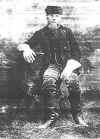 OLDER STACE
OLDER STACE
On campus, Stace was an unusually active member of the Faculty and lived in the
old Main Building. His eccentric and eclectic attitude made him one of the more
colorful figures in the history of the university. Stace, like Howard, had a
broad interest in all things, both on and off Campus, which helped to develop
his reputation as a scholar, poet, engineer, scientist and philosopher. At one
time he directed a group of engineers on a project in the Northwest. In 1874 he
was elected County surveyor for St. Joseph County, Indiana, and served until
1880. He frequently edited editions of the University newspaper, The Notre
Dame Scholastic, and was a steady contributor of stories, and humorous
poetry to it.
In 1886, Stace became the first Dean of the Engineering College. One of the
first things he did was to complete plans for a new “Badin Observatory” and
he announce an impending ground breaking for it. For unknown reasons, the ground
breaking did not occur until October 1891, after Stace’s demise. By this time
Professor Timothy Howard had returned to the University, after a hiatus, and was
again placed in charge of the telescope and its subsequent reconstruction.
In 1888, at the request of Congressman Shively of Indiana, Professor Stace was
selected by President Cleveland as one of the scientific experts in charge of
American interests, and asked to report to the Government on matters connected
with the 1889 Paris exhibition. He received his commission on September 17, 1888
and began his preparations to travel to Paris in December or January.
Unfortunately he became seriously ill and was confined to his bed for a while.
Stace’s principal duty was to review and report on all national exhibits,
including those of the United States. His report was formally published by
the U.S. Government, two years later, in Reports of the United States
Commissioners to the Universal Exposition of 1889 at Paris.(20a)
Stace returned to Notre Dame in Mid-September and to many, his health appeared
much improved. He resumed his habit of walking each morning before breakfast to
neighboring Niles, Michigan, but he was frequently tired and reportedly has to,
"take the cars back." It was on these walks that some people felt he
was eccentric. The South Bend Tribune reported: “He loved solitude and
indulged in long walks alone. To see him sauntering along the highway in top
boots, with the trousers legs inside, a rough corduroy suit on, and a slouch hat
hiding his blonde hair, he would be mistaken by any other than a good reader of
physiognomy, for a farm laborer in search of work, or anything else in fact,
than a college professor."(20b)
In December of the year, Stace was honored by the French Government with the
appointment of, "Office of Public Instruction - Diploma from Minister of
Worship at Paris." But ill health returned and he died on September
25, 1890. Funeral services were held at the college church . He was buried in
the Community Cemetery at Notre Dame, one of the few laymen accorded the
honor of being buried among the Holy Cross priests and brothers. (20c) His
monument is one of the more prominent in the cemetery.
 CAMPUS VIEW WITH OBSERVATORY
CAMPUS VIEW WITH OBSERVATORY
For unknown reasons, the ground breaking for the observatory did not occur until
October 1891.(21) By this time Professor Timothy Howard had returned to
the University, after a hiatus, and was again in charge of the telescope and its
subsequent reconstruction. After that date, however, things moved quickly and
the building was ready for the 1892 - 93 school year.(22)
 OBSERVATORY
OBSERVATORY
A contemporary description of the observatory, written by Professor Howard,
states:
"The astronomical observatory consists of a main part, with a revolving
dome, an east wing or transit room, in which is mounted the transit instrument,
and a north wing or computing room, which contains the smaller instruments and
works of reference for the use of the observers." (23)
The building was located on the then South-East side of the campus near the site
of the old business school. Later accounts report that it had a black-painted
spherical turret, which revolved by clock-work in an opposite direction to the
movement of the earth upon its axis to permit a constant focus.
 W&S MOUNTING
W&S MOUNTING
In anticipation of the opening of the new observatory, the Napoleon telescope
was completely re-built with a clock-work drive and fixed mounting by the
Warner & Swasey Company of Cleveland, Ohio, to appear as it does today. The
Foucault lens of the original Napoleon instrument was also reworked by Mr. J. A.
Brashear of Pittsburgh, in conjunction with Warner & Swasey, who fitted them
into the new telescope. (24)
Incidentaly, Robert Todd Lincoln, Abraham Lincoln's son was an amateur
Astronomer, and about the same time that Warner & Swasey reconstructed our
telescope, bought one for his own use from the company that is a match for
ours. This may be seen at his home in New Hampshire.
In 1894 a little luxury was added for the astronomers with the purchase of a
modern telescopic chair to replace an old stool and a stepladder that had been
used to sit on during observations. (25)
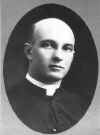 FR.
DE WULF FR.
DE WULF
The observatory and telescope operated quietly for the next two decades until
1919 when the University hired Fr. Emil De Wulf, C.S.C.. This lead to the
foundation of the university's separate Department of Astronomy in 1925 with Fr.
De Wulf as its head. Fr. De Wulf was a South Bend native who graduated from the
University of Notre Dame in 1903. He was the first full-time, astronomy trained
professor to be hired by the University, and had been President of St. Edwards
College in Austin, Texas, before returning to Notre Dame. While at Notre Dame he
took additional graduate work in astronomy at the University of Chicago. In 1921
he was interviewed by a local newspaper regarding his opinion on life on Mars.
More important, however, in the article, it stated: "Notre Dame school in
astronomy is acknowledged to be in its infancy, but one of the salient features
of the plan for a Greater Notre Dame will furnish the university with another
observatory and a telescope for observation far greater in size than the one now
possessed and reverenced for its coming here from France."(26)
Unfortunately Fr. De Wulf died in May 1930. He was succeeded by Father James E.
Kline, C.S.C., who was Assistant Professor of Astronomy and had received his A.B.
from Notre Dame in 1922. He later obtained a Ph. D. in astronomy. One year after
Fr. De Wulf's death the observatory was again moved.
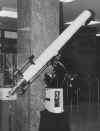 TELESCOPE IN LIBRARY
TELESCOPE IN LIBRARY
At this point the fate of the observatory became precarious and its location as
well as that of the telescope within it becomes complicated. With the
commencement of the construction of the Hurley Hall of Business Administration
the space occupied by the observatory had to be evacuated. It has been reported
that the observatory was moved to a hill East of the University tennis courts.
(27) A photograph in the 1932 Dome shows the observatory in the
background of the picture of the 1931 Freshman football squad, with a fence
dividing it from the old football field. Here after the observatory disappeared
from view, and after the 1933-34 University Bulletin, the observatory is no
longer mentioned, and was perhaps dismantled.(28)
In June 1934 Fr. Klein was now living at St. Augustine's Church in Oakland,
California, and studying at the University of California in Berkeley. He wrote a
series of letters to the then Dean of Engineering and the president of the
university in attempt to save the observatory and restore the telescope.
However, since it was the hight of the depression, the University could not
afford it.
In any event the observatory was dismantled, the telescope stored away, and by
1940, the Department of Astronomy as such was abandoned also by the University.
However, descriptive courses in astronomy are still offered to this day.
Various rumors existed regarding the demise of the Observatory still exist
today. Rumors of the disposition of the observatory dome range from its sale to
a person in Elkhart for business purposes to abandonment on a back lot at St.
Mary's College. (29) The telescope, however, was placed in storage on the Notre
Dame campus where it remained until 1955.
In 1955 a young student and later priest, Fr. James Shilts C.S.C., and a group
of graduate students wished to observe what may have been a perihelic opposition
of Mars. Shilts, like Fr. De Wulf was a native son of South Bend. he was a
graduate of the University of Notre Dame, and the son of a professor at Notre
Dame.
 TELESCOPE ON ROOF
TELESCOPE ON ROOF
The students and Shilts, reportedly cut their classes, and carried the
dismantled telescope from its storage to the roof of the newly constructed
Nieuwland Science Hall. Attempts to body hold the heavy tube for observation of
Mars could not have been very successful, so soon the entire telescope including
its heavy base was assembled on the roof. This must have been a difficult task
for even now, when parts need to be repaired, the base remains anchored.
Protecting the telescope from the cruel Indiana weather also was a consideration
and a tarpaulin cover had to be made to protect it. The rough usage and the
environment soon took its toll, the clock-drive became frozen, gear shafts were
broken and the objective lens became uncemented.
In 1959, the now Fr. Shilts, who had become a professor of astronomy, was able
to secure funds from then president Fr. Hesburgh, to repair the telescope and
lens and build a protective shed on the roof of Nieuwland Hall. The cleaning and
repair of the telescope was undertaken by Mr. Fred O'Callaghan of Franklin Park,
Illinois at the advice of the staff at the Adler Planetarium in Chicago. The
work was completed in February 1960.(30)
Over the past years the telescope has been in use by students, faculty and staff
for class instruction and small research projects. It has been cleaned and
adjusted several times over the years, most recently in December 1993.. On two
occasions the unmounted telescope has been on display in the university library.
Once for an exhibit I prepared in 1986 on Halley" comet and again in 1993
after a refurbishing. More recently a Semi-annual History of Asrtonomy Workshop
has been held at Notre Dame. Each Workshop involves nearly 100 astronomers,
historians and science writers. A high point after the closing banquet has been
a quiet stroll across campus to Nieuwland Science Hall for a look through our
famous Napoleon Telescope at the beautiful night sky.
BIBLIOGRAPHY
NOTE: Special thanks are necessary for the basic research on
the early history of the Notre Dame telescope compiled by Timothy Reilly for the
two articles cited below.
Reilly, Timothy. A History of the Notre Dame Telescope. Paper,
History
of Science III, May 10, 1974. 20pg.
Reilly, Tim. The History of Notre Dame's Observatory. Notre Dame Science
Quarterly, Vol.XIII, No.1, November 1974. pg.26 - 29.
END NOTES
1)Annual Catalogue of the Officers and Students of the University of Notre
Dame, Indiana, for the 1865-66 Academic year. (Notre Dame, Ave Maria Press,
1866) , pg, 3.
2)Annual Catalogue of the Officers and Students of the University of Notre
Same, Indiana for the 1966-67 Academic Year. Notre Dame, Ave Maria
Press, 1867) pg.4.
3)"Magnificent Present to Notre Dame University". St. Joseph Valley
Register,June 6, 1867, pg. 3.
4) New York Tablet, June 20, 1867.
5)The National Union,June 1, 1867. pg.3.
6) Napoleon III. [Charles] Louis Napoleon [Bonaparte] (1808-1873), had a
deep interest in science, technology and history. He enjoyed doing research and
published a book, Fragments Historiques, 1688 et 1830, as well as
newspaper articles and another book about the history of artillery. At one point
in his life he had decided to study chemistry and set up a laboratory to study
electro-magnetism.
Jean Bernard Leon Foucault (1819-68) was a French physist who is best known for
his demonstration , with a long pendulum, that the Earth rotated on its axis..
In the year 1851, EmperorNapoleon III gave Foucault permission to attempt his
ecperiment in the Pantheon in Paris. Foucault also invented the knife-edge test
for mirrors and lenses. In addition he developed the heliostat and silver
coatings for mirrors, measured the speed of light, and demonstrated that
light travels more slowly in water than in air.
7) Magnificent ... op. cit.
8) Dumas, Maurice. Les Instruments |Scientifiques aux XVIIe et XVIIIe Siecles.
Paris, Presses Universitaires de France, 1953. 417pg.
9) Notre Dame Scholastic, October 5, 1867. pg. 7.
10)Notre Dame Scholastic. Vol.III, No. 8, December 25, 1869.
11) Notre Dame Scholastic. Vol.III, No. 16, April 16, 1870. pg.
12) Notre Dame Scholastic, January 27, 1872, pg.7.
13) Notre Dame Scholastic Vol.III, No.6, Nov.27, 1869.pg 47.
14) Notre Dame Scholastic Vol. III, No. 16, April 16, 1870. pg. 126.
15) Notre Dame Scholastic.Vol. III, No. 17, April 30, 1870. pg. 133.
15a) Noyre Dame Scholastic, XI
16) Notre Dame Scholastic Vol.XIII, #4, Sept. 27. 1879.
17) Notre Dame Scholastic Vol.XIII, #15, Dec. 13, 1879. pg.233.
18) Notre Dame Scholastic Vol.XIII, #34, May 1, 1880. pg. 537.
19) Notre Dame Scholastic Vol.XIV, #10, Nov. 20, 1880. Pg. 155.
20) Notre Dame Scholastic. Vol. XIX, #29. April 3, 1886, pg. 468.
20a)Stace, Arthur J., "Education and the Liberal Arts" Vol.II,
pg.115-192, Report of the United States Commissioners to the Universal
Exposition of 1889 ..., Washington, D.C., GPO, 1890-91. 5 vol.
Stace's report was not all serious. He had an irascible personality and sense of
humor. One of the more incongruous United States exhibits in C1; Ordinary
Applications of the Arts of Drawing and Modeling was, "The Venus De
Milo" molded in chocolate weighing 1,400 pounds, by Henry Millars of New
York.Of this Stace said,
"As of Maillard's chocolate Venus we do not know what to say. Venus is
presumably sweet in any form, but in chocolate she may be thought too sweet for
any use. At the time of this writing, however, she shows the result of various
nibblings, although the Ehposition is not half over."
20b) South Bend Weekly Tribune, October 4, 1890. pg. 2.
20 c) Notre Dame Scholastic, 24:4, September 27, 1890. pg 60.
21) Notre Dame Scholastic, Vol. XXV, #6, October 10, 1891, pg.97.
22) Notre Dame Scholastic, Vol. XXV, #23, February 13, 1892. pg. 398.
23) Howard, Timothy. A History of St. Joseph County. Chicago, Lewis
Publishing Co., 1907. Vol.II, pg. 674.
24) Warner & Swasey. A Few Astronomical Instruments from the Works of
Warner & Swasey. Cleveland, Ohio, Warner & Swasey, MDCCCC. plate II.
25) Notre Dame Scholastic. April 7, 1894. pg. 491.
26) Lewis, Grant. Notre Dame Astronomer Does Not Believe Mars Inhabited.
South Bend Times. October 16, 1921.
27) Notre Dame Scholastic. May 15, 1931. pg. 853.
28) Bulletin of the University of Notre Dame. Notre Dame, University
Press, 1931, Vol.27, No.3, pg.39.
29) Notre Dame Science Quarterly. Vol. XIII, #1, November 1974. pg. 28.
30) Reilly. ibid. pg.29.
All images and text provided courtesy of Robert Havlik.
|

 TELESCOPE FROM CATALOG
TELESCOPE FROM CATALOG


















